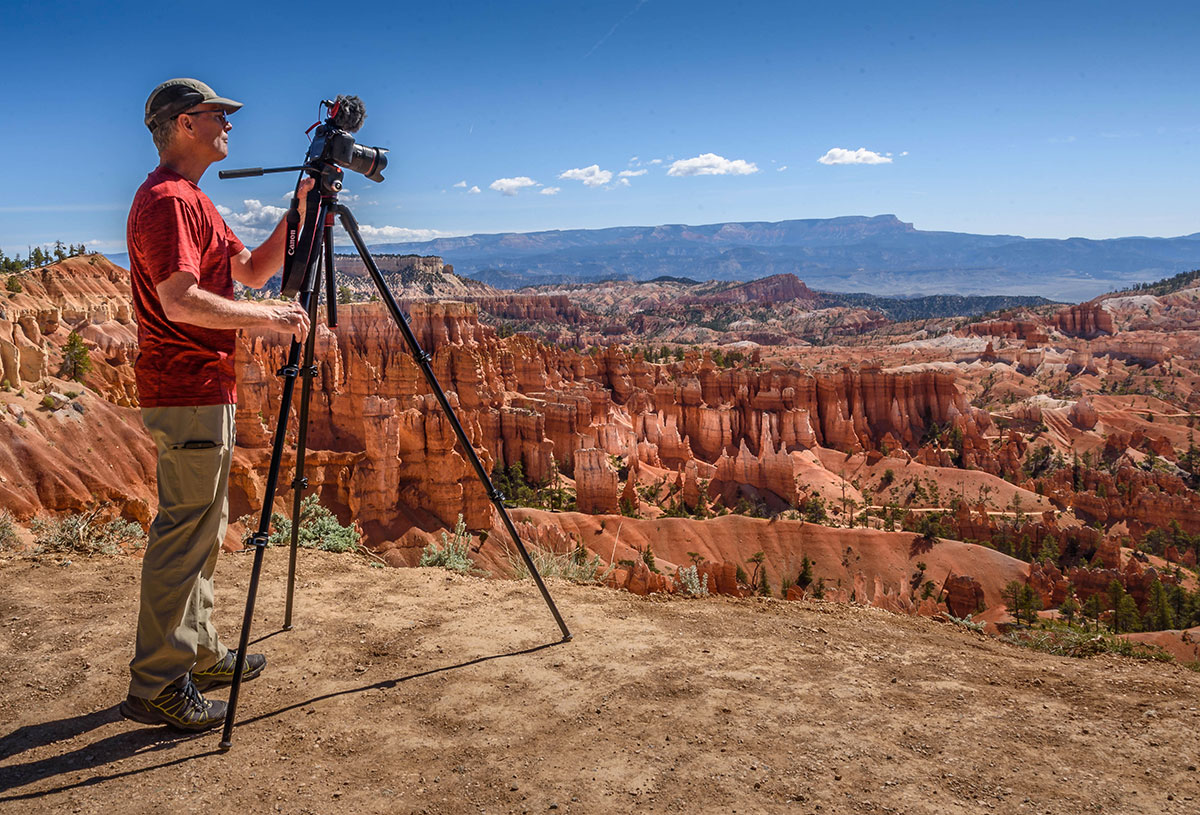Hoodoos Galore!
Explore More in National Parks
Bryce Canyon National Park
Rusted and eroded coliseums of limestone towers - called hoodoos.
Elevation:
Approximately 7,000' (2,133m) at the base and just over 9,000' (2,743m) at its highest point.
The first pioneer explorer of this area lost something here, and he must have felt he was dreaming when he found what he was looking for. Situated to the west and above the lesser-known Paria River you'll find Utah's forested Pansaugunt Plateau which stretches southward for 20 miles from its beginnings. Rising up from the surrounding valleys on the east, south, and west, the buttress walls of the Paunsaugunt Plateau rise between 700 and 2,000 feet above the valley floor to reveal multi-hued eroded rock walls of limestone. The eastern edge of this plateau and portions of the greenery on top comprise what is now known as Bryce Canyon National Park, which is referred to as a canyon, but is actually a long series of bowl-shaped eroded and rugged rock amphitheaters.
BRYCE CANYON - A CANYON, A DREAM, OR A PLACE TO GET LOST?
These bowl-shaped amphitheaters are spread intermittently across twenty miles of the side of the plateau and are populated with thousands of formations of varying sizes and shapes, commonly referred to as hoodoos, but that one ambiguous term does not do justice to what is found here. Native Americans of the 1800's were said to refer to the canyon as a place where men stood with no hands. The hoodoos or stone towers are often congregated together in long walls, or groupings of hoodoos, that create vast buttresses of stone that might resemble an army standing watch on the walls of a castle. The hoodoos themselves are colored in shades of ochre, orange, pink, and red and these many and varied colors are caused by the oxidizing of the iron mineral within the rocks themselves. To put it plainly, various levels of rust has created the colors within the rock, and the shapes are created by the ongoing erosive work of water and wind.
WHERE ELSE DO WE SEE HOODOOS IN UTAH?
These types of formations are part of a layer of sediment found prominently in this region of southwestern Utah, and can be seen in nearby locations such as the higher Aquarius Plateau (Boulder Mountain), or in nearby Red Canyon, and also further to the southwest along the Virgin River Rim which is part of the Markagunt Plateau. The Markagunt Plateau includes Cedar Breaks National Monument which is a much smaller version, and less filled with hoodoos, than what is seen at Bryce Canyon National Park.
HOW ARE THE HOODOOS OF BRYCE CANYON CREATED?

The method in which the shapes of Bryce Canyon are created is an interesting process, and one that is quite simple once the we understand the details. At higher elevations these towers of stone are subjected to moisture from rain or snow that is fed by gravity deep into the crevices of the rock. In early spring or late fall daytime temperatures are generally warm enough to avoid freezing, but at night the temperatures can drop below 32 degrees Fahrenheit (o degrees Celsius). In winter the temperatures, day or night can penetrate the moisture within the rock and freeze, thus causing expansion within the crags. This bloated ice splits slabs apart and it is not uncommon, in colder temperatures, to view or hear stones tumbling down the hillsides.
WHAT OTHER SHAPES ARE FOUND AT BRYCE CANYON?

The erosional forces of this national park have also created narrow slot canyons, natural arches and bridges, monoliths and spires that rise almost finger-like into one of the bluest skies on planet earth. Read more about blue skies below. From a geologic standpoint, scientists indicate that this entire region is primarily composed of sedimentary rocks that were once layers of debris deposited here during cetaceous, paleocene, and oligocene periods. In other words, a very long time ago. Over time these blankets of sediment became cemented together and now are subsequently being torn apart in a slow disintegration process.
WHY IS THE AIR AND SKY SO CLEAR AND BLUE ABOVE BRYCE CANYON?

The geographic county that surrounds this attraction covers an area of approximately 4,000 square miles and is permanently inhabited by just over 4,000 people, and this is one factor that has kept the skies overhead in more pristine condition. Steady high elevation breezes, and the lack of smog or night-time light pollution enables daytime skies to remain a deep cerulean blue that is only interrupted by the generally white and puffy clouds that roll by.
Clear daytime views from Bryce Canyon extend to over 100 miles, primarily toward the east and south where distant formations such as Navajo Mountain, sacred to the Navajo Native American tribe, can be seen towering over 10,000 feet in elevation above the terrain of Lake Powell and the Colorado River.
Clear daytime views from Bryce Canyon extend to over 100 miles, primarily toward the east and south where distant formations such as Navajo Mountain, sacred to the Navajo Native American tribe, can be seen towering over 10,000 feet in elevation above the terrain of Lake Powell and the Colorado River.
WHAT IS THE HISTORY OF BRYCE CANYON?

Rising from the many valleys of this region, are stair-stepping plateaus, each one elevating slightly higher or lower than it neighbor. These valleys are plateaus have been utilized for several thousand years by various groups of people. Prior to about 800 years ago the ancestral Puebloan and Fremont cultures lived in this region, and more recently Indian tribes such as the Navajo, Ute, and Paiute began to live here as they supplanted the peoples that were here before them. In the mid-1700's a small group of explorers from the country of Spain entered the region but likely did not enter Bryce Canyon or even know of its existence. In the mid-1800's pioneer settlers who were members of the Church of Jesus Christ of Latter Day Saint, also nicknamed Mormons, began to settle the valley that surround the areas plateaus. During a time known as the Black Hawk Wars, of the late 1860's, many of these settlers were forced to leave their homes and congregate in safer places until better relations with the Indians were restored. Interestingly it wasn't until 1872 that a man by the name of Ebenezer Bryce went looking for some of his lost cattle and, in doing so, he stumbled into one of the main rock coliseums. He was the first known pioneer settler or European explorer to view what is now viewed by thousands on a daily basis. We can only imagine his initial reaction to what he saw. Historical records indicate that his main comment after returning with his cattle did not reflect his awe, but rather a more practical observation of "It's one hell of a place to love a cow." Soon after this experience other locals ventured into the amphitheaters to explore and experience the area for themselves. These new area residents began to refer to what they say as Bryce's canyon. It was yet another 50 years before locals and public officials garnered enough support to set aside and protect the area as a national park (1928).
WHAT TYPES OF WILDLIFE ARE FOUND IN BRYCE CANYON?
The high mountains and plateaus of Utah are filled with wildlife and it is quite common to have sightings, in and around the park, of squirrels, chipmunks, rabbits, prairie dogs, mule deer, pronghorn antelope and especially the big and bold black ravens that are so common in the west. While rarely seen their are black bears, mountain lions, bobcats, and elk that inhabit this region. Birding enthusiasts will enjoy the semi-common view of bluebirds, jays, and swallows, while it is more rare to view the more seclusive owls, falcons, golden eagles and bald eagles. It should be noted that bald eagles may be more prominently seen during winter months when they are temporarily in higher numbers in Utah, after migrating from Canada and Alaska. These numbers commonly deplete in early spring as the bald eagles return to their summer homes. For reptiles horned lizards (horned toads) and other small lizards are fairly common while a view of various native snakes, including rattlesnakes, is far less common. Researchers have identified as many as 60 species of butterflies in the area, and there are many other insects commonly found in the high mountains of the west during warmer times of the year.
ARE THERE HIKING TRAILS IN BRYCE CANYON?

Most people experience this areas hiking trails that follow along the top of the plateau, as this enables a view across and down into the depths of the coliseums of rock. Hiking trails, some paved, but mostly dirt trails, stretch for many miles across the forested plateau or downhill amongst the hoodoo towers. Most commonly used trails are those that lead from vehicle parking areas, where restroom facilities may also be found, out to scenic overlooks or along the rim of the amphitheaters. These trails that lead to these viewpoints are generally of shorter distance, but remember that the elevations are between 8,000 and 9,000 feet and so the air is thinner and therefore it is more difficult to acquire needed oxygen. We invite you to keep this in mind as you determine where, and how far, you will walk or hike to catch a view of the remaining eroded skyscrapers.
Trails that descend below the rim of the plateau are fairly steep so it is important to consider that any distance traveled downward must also be ascended on the return portion of a hike. Most people are a little surprised at the amount of energy and fitness it takes to hike uphill in this national park. Wise hikers will remember that preparation makes for the best experience and to bring some snacks, water, good hiking shoes, a good hat, their best camera, and even a walking stick or trekking poles. Trails for walking or hiking are normally well maintained, but erosion can sometimes cause trail blockages or damage and wet trails can become difficult to navigate as the soil can be very clay-like, sticky, and slippery. Stay aware of temperatures and other weather conditions, and bring appropriate clothing, plus remember to apply sunscreen to cover skin that will be exposed to more penetrating sunlight of this area's high elevations. We encourage all to stay on trails and avoid damaging sensitive foliage, soils, disturbing wildlife, or endangering themselves or fellow explorers.
Trails that descend below the rim of the plateau are fairly steep so it is important to consider that any distance traveled downward must also be ascended on the return portion of a hike. Most people are a little surprised at the amount of energy and fitness it takes to hike uphill in this national park. Wise hikers will remember that preparation makes for the best experience and to bring some snacks, water, good hiking shoes, a good hat, their best camera, and even a walking stick or trekking poles. Trails for walking or hiking are normally well maintained, but erosion can sometimes cause trail blockages or damage and wet trails can become difficult to navigate as the soil can be very clay-like, sticky, and slippery. Stay aware of temperatures and other weather conditions, and bring appropriate clothing, plus remember to apply sunscreen to cover skin that will be exposed to more penetrating sunlight of this area's high elevations. We encourage all to stay on trails and avoid damaging sensitive foliage, soils, disturbing wildlife, or endangering themselves or fellow explorers.
WHAT ARE THE NAMES OF BRYCE CANYON'S MOST PROMINENT HIKING TRAILS?
Easy to Moderate
- Bristlecone Loop - (1-hour walk/hike - Rainbow Point).
- Mossy Cave (Accessed via Scenic Byway 12. Near Tropic Utah, one hour hike).
- Queens Garden / Navajo Loop (From Sunrise and/or Sunset Point - 2-3 hours).
- Rim Trail (Walk as far as you choose along the main amphitheater rim).
- Tower Bridge (2-3 hours, north of Sunrise Point).
Challenging Hikes
- Fairyland Loop (4-5 hours, Fairyland Point).
- Peekaboo Loop (3-4 hours, Bryce Point).
- Bristlecone Loop - (1-hour walk/hike - Rainbow Point).
- Mossy Cave (Accessed via Scenic Byway 12. Near Tropic Utah, one hour hike).
- Queens Garden / Navajo Loop (From Sunrise and/or Sunset Point - 2-3 hours).
- Rim Trail (Walk as far as you choose along the main amphitheater rim).
- Tower Bridge (2-3 hours, north of Sunrise Point).
Challenging Hikes
- Fairyland Loop (4-5 hours, Fairyland Point).
- Peekaboo Loop (3-4 hours, Bryce Point).
PLANNING YOUR TRIP
This is considered by many to be one of the most visually and geographically unique national parks on this earth, and it is considered by many to be a world-class destination for hikers, photographers, and nearly any type of outdoor enthusiast. As you venture around the park you'll likely hear people speaking the languages of Europe, Asia, South America or the unique English speaking accents of England, Scotland, Ireland, Australia, New Zealand, or South Africa.
Bryce Canyon sits at the southwest end of Utah's All American Highway, Scenic Byway 12, and travelers to this region will enjoy this route that connects to Capitol Reef National Park on the north, while passing near-to or through three state parks, a national forest, and a national monument.
One state park that is close by is Kodachrome Basin, a destination that is very unique for the manner in which the formations in this park were created. Read more about Kodachrome Basin, just 17 miles away, and you likely find that this is also a worthy addition to your trip itinerary.
Just 75 minutes to the south, just below the Markagunt Plateau is Utah's most popular scenic attraction - Zion National Park, and further south you can ascend the Kaibab Plateau to North Rim of Grand Canyon. To the east of these parks are even more national and state designated destinations and attractions. There's just so much in in this area that it's no wonder that some say it is the World's Greatest Concentration of Natural Scenic Wonders. You'll be hard-pressed to have enough time to experience each one, and there are good reasons to try not to cover too much ground in one trip, so it's best to plan a return trip to fully experience other sections of Utah.
Guided outdoor adventures are readily available through local guides and outfitters that offer guided or equipment for excursions for such activities as; horseback riding, off-road tours, mountain bike rentals, and others. Self-guided experiences in the area also include fishing, photography, bird watching, hiking, and star gazing.
Be sure to check the park’s official website or stop by a local visitor center to obtain current information on road, weather, and other conditions, and to gather tips on how to best experience the park. The weather in the area can vary greatly so it's important to plan accordingly and bring along clothing and gear to comfortably experience Bryce Canyon.
Bryce Canyon sits at the southwest end of Utah's All American Highway, Scenic Byway 12, and travelers to this region will enjoy this route that connects to Capitol Reef National Park on the north, while passing near-to or through three state parks, a national forest, and a national monument.
One state park that is close by is Kodachrome Basin, a destination that is very unique for the manner in which the formations in this park were created. Read more about Kodachrome Basin, just 17 miles away, and you likely find that this is also a worthy addition to your trip itinerary.
Just 75 minutes to the south, just below the Markagunt Plateau is Utah's most popular scenic attraction - Zion National Park, and further south you can ascend the Kaibab Plateau to North Rim of Grand Canyon. To the east of these parks are even more national and state designated destinations and attractions. There's just so much in in this area that it's no wonder that some say it is the World's Greatest Concentration of Natural Scenic Wonders. You'll be hard-pressed to have enough time to experience each one, and there are good reasons to try not to cover too much ground in one trip, so it's best to plan a return trip to fully experience other sections of Utah.
Guided outdoor adventures are readily available through local guides and outfitters that offer guided or equipment for excursions for such activities as; horseback riding, off-road tours, mountain bike rentals, and others. Self-guided experiences in the area also include fishing, photography, bird watching, hiking, and star gazing.
Be sure to check the park’s official website or stop by a local visitor center to obtain current information on road, weather, and other conditions, and to gather tips on how to best experience the park. The weather in the area can vary greatly so it's important to plan accordingly and bring along clothing and gear to comfortably experience Bryce Canyon.
Photo gallery
Planning your trip
AIRPORTS
- BRYCE CANYON AIRPORT: This very small and historic airport is the landing and take-off spot for scenic day-trip flights originating from Las Vegas. There are also some local scenic aerial tours that depart from this airport.
- CEDAR CITY REGIONAL AIRPORT: There are connecting flights available directly from Salt Lake City and Cedar City is just a one and a half hour drive to the park. Car rentals are available in Cedar City.
- ST. GEORGE REGIONAL AIRPORT: Connecting flights from Salt Lake City, Los Angeles, Phoenix and Denver are now available at this growing regional airport. It takes approximately two hours to drive from St. George, Utah to Bryce Canyon.
- LAS VEGAS INTERNATIONAL AIRPORT: Las Vegas is a major airline destination and flights to and from many foreign and domestic destinations are available. Vehicle rentals are abundant in Las Vegas and it takes just under four hours to drive to Bryce Canyon via Interstate 15 on the fastest route. There are of course many scenic routes to take.
- SALT LAKE CITY INTERNATIONAL AIRPORT: This is another major airport hub with flights from national and international destinations. The drive from Salt Lake City to Bryce Canyon is similar to that of Las Vegas and is approximately four hours.

lodging/camping
Bryce Canyon National Park offers a variety of lodging options, particularly in the cities of Bryce Canyon City, Tropic, Panguitch and Hatch. Lodging options range from hotel rooms and campgrounds to cabins and vacation homes.

dining
There are a number of restaurants and fast-food places in the cities and towns that are mentioned above. Restaurants range from fine dining spots to fast-food places that will give you a quick meal if you need it.

Fees/permits
Entry into Bryce Canyon National Park has fees per vehicle and fees per person for those on foot, bike, or motorcycle. Other fees and permits may be required for certain activities, such as camping or backcountry use. Be sure to check with the park before you arrive to make sure you have all of the necessary information or check out the National Park website for more information.

Pets
Pets are welcome in Bryce Canyon National Park but must be kept on a leash at all times and cannot enter park buildings or lodges. Dogs are also not allowed on any of the backcountry trails or within 100 feet of water sources. It is important for pet owners to always clean up after their pets, as well as remain mindful of wildlife and other visitors.
SHOPPING
Bryce Canyon City is located just outside the park and has a great selection of food, supply, and souvenir options. There are several cities and towns around Bryce Canyon (Tropic, Panguitch) which offer a variety of shopping options, from souvenir shops to grocery stores and everything in between. Whether you’re looking for hiking gear, camping supplies or just a few mementos to take home with you, there’s something for everyone.
BEAT THE CROWDS
Bryce Canyon can be a busy place on most weekends between April and mid-October. Weekdays may also be busy during this time frame. Many people have learned that starting very early is a good way to beat the crowds. The other best choice is to visit the park later in the afternoon when many visitors may be leaving the park. For the best experience on busy days we suggest you obtain a parking spot early and select lesser-known trails.
Nearby Activities & Attractions
Horseback riding
Horseback Riding in Bryce Canyon is available during warmer months (April – October, weather permitting). Horseback Riding in Bryce Canyon is available during warmer months (April – October, weather permitting). ATV tours, helicopter tours and other guided experiences are also available. Local outfitters and guides provide hiking, horseback riding, UTV or ATV experiences, bike rentals (pedal/electric), and more. View listings for these outfitters below.
Red Canyon
Northwest of Bryce Canyon along Scenic Byway 12, and two miles east of the junction with Highway 89, you'll find Red Canyon. This area looks much like Bryce Canyon and is a part of the Dixie National Forest.
Kodachrome basin
Just 20 minutes from Bryce Canyon National Park is Kodachrome Basin State Park. This Utah state park offers 67 sedimentary chimney rocks, ranging from up to 170 feet in height. Researchers have determined that this area was once a geyser basin similar to what is found in Yellowstone National Park. Over time, when the geysers ceased to function, the remaining holes created by the geyser were filled with sediment. This debris hardened into rock and was more dense than the surrounding strata which eventually eroded away, leaving these hardened sediment towers standing as tall remnants of the geyser era.
OTHER ATTRACTIONS
- Grand Staircase Escalante National Monument
- Lake Powell / Glen Canyon
- Anasazi Indian Villages State Park
- Calf Creek Falls
- Devils Garden
- Escalante Petrified Forest State Park
- Scenic Byway 12
Photography
Photographers will appreciate the colorful array of towers and vistas. Best light for rim shots is morning and evenings but light conditions can be different among some of the narrow passages among the hoodoos. Sunsets and sunrises are breathtaking and puffy monsoon season clouds may be frequent in summer but less prevalent in winter. Bryce Canyon National Park has great protection from man-made lights and is designated an International Dark Sky destination.
